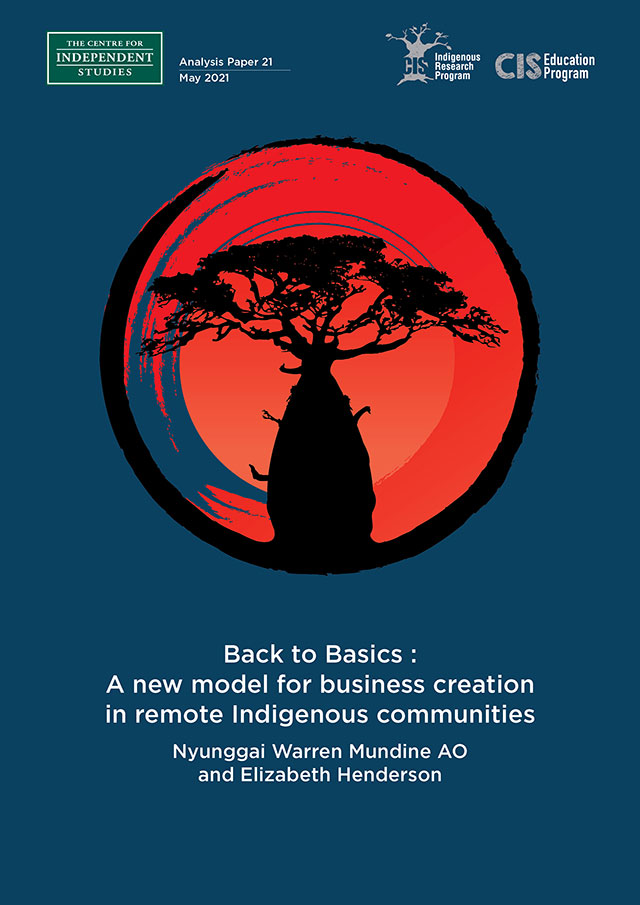
This paper focuses on a new model to increase the potential for Indigenous business creation in remote communities.
The past decade has seen significant growth in the Indigenous business sector fuelled by landmark Commonwealth policies such as the Indigenous Business Sector Strategy. However, these policies have not succeeded in remote Australia where Indigenous economic participation through business creation is most needed.
This paper calls for an overhaul of the current approach. It outlines a practical model for business creation in remote Indigenous communities that harnesses the fundamental principle of supply and demand and what the authors identify as the Three Foundations of business creation — Capability, Entrepreneurship and Business Support.
Indigenous business creation: overview
The model could be implemented in one community or at scale. It could be repositioned out of existing programs and initiatives and could even pay for itself. For governments, it could be implemented without any additional funding beyond what is already allocated in these areas through reorganisation of existing structures and programs.
Remoteness is not the main problem. The natural cycle of supply-and-demand has been stifled by structures imposed on Indigenous communities — by legislation, by the legal framework for Indigenous lands, and by government programs — and the mindsets that have developed as a consequence. The key requirement (and challenge) is therefore a mindset that understands — and more importantly believes in — business and entrepreneurship.
Key points
Remote Indigenous communities desperately need businesses and jobs. This paper explores Indigenous economic participation in remote Australia through business and entrepreneurship, with a new model for business creation
Authors Nyunggai Warren Mundine AO and Elizabeth Henderson point out that Indigenous people in remote areas are the poorest and have the least economic participation. “There is another gap developing — the gap in economic and social indicators between Indigenous people who live in the cities and those who live everywhere else,” Mundine says.
The paper details ways to overcome the impediments to businesses being started in remote communities, including access to finance, training and certification, and low levels of administrative experience and financial literacy.
The new Indigenous business creation model is based on the economic principle of supply and demand, and includes analysing communities’ readiness for business creation and development, and applying criteria that categorise them as either ‘Business Ready Communities’ or ‘Low Readiness Communities’.
The ‘Three Foundations’ for Indigenous business creation in the model are:
- Capability: the ability or capacity to provide goods or services someone else is willing to pay for.
- Entrepreneurship: the ability to see opportunities for income generation and the will and motivation to pursue them.
- Business Support: to ensure the business operates legally, the business owner and management stays on top of paperwork, and the company remains financially viable.
The paper also outlines that traditional debt funding is not a good model for Indigenous business creation in remote Australia (other than things like debt financing secured by specific equipment). “More realistic funding structures are those that have similar characteristics to equity and grants,” Mundine says. “Approval criteria should not include confidence that the new business will be a success.”
The Indigenous business creation model outlines a simplified approval criteria based on:
Supply: confirming the Three Foundations are present; and
Demand: demand for the goods or services to be provided by that business in the particular remote community, with criteria for ‘deemed demand’, where:
- the goods or services are currently not available in the community; or
- the goods or services are supplied in the community but the only current suppliers are located outside the community (e.g. more than two hours by road); or
- the business has a commitment from a prime contractor, customer or client to enter into a contract which will generate revenue.
A condition of funding should be that the funded entity is a for-profit business. A person can only build a livelihood out of a for-profit business. The paper emphasises that business creation in remote Indigenous communities is not dependent on governments. But governments, as the major operators in these communities, can put greater focus on business creation and can do so without new programs or funding.
Existing resources can be repositioned to deliver Indigenous enterprise and small business development through their own functions. Joint venture approaches — long a core part of Indigenous business creation initiatives — should be reconsidered.
There are legitimate concerns about ‘black cladding’ — where businesses meet the technical requirements for Indigenous ownership and directors, but the non-Indigenous business partner exerts control and gains more of the benefits through contracts — and also great scope for abuse by unscrupulous operators.
Other than family businesses,
- The entire approach to joint ventures should be reconsidered;
- There should be a full financial and operational audit and review of joint ventures (whether 50% or 51%) being awarded contracts under the IPP; and
- This should lead to assessment and review of the real level of Indigenous economic participation resulting from joint ventures.
Also by Nyunggai Warren Mundine: It’s The Economy, Stupid: Economic participation only way to Close the Gap
SELECTED REFERENCES
- 8165.0 Counts of Australian Businesses, including Entries and Exits, June 2015 to June 2019, released 20 February
2020. - Australian Bureau of Statistics, Australian Statistical Geography Standard (ASGS): Volume 5 – Remoteness
Structure, July 2016, 1270.0.55.005 - Australian Bureau of Statistics, Population Projections, Australia, 2012 to 2101, 3222.0, 2013.
- Australian Bureau of Statistics, Estimates and Projections, Aboriginal and Torres Strait Islander Australians, 2001 to 2026, 3238.0, 2014.
- Australian Bureau of Statistics, Estimates of Aboriginal and Torres Strait Islander Australians, June 2016.
- Australian Bureau of Statistics, Data by Region – Statistical Area Level 2 (SA2) for Halls Creek (Region code: 510011264), Kununurra (Region code: 510011265) and Derby-West Kimberley (Region code: 510011263)
- Commonwealth of Australia, Creating Parity – the Forrest Review, 2014
- Commonwealth of Australia, Department of the Prime Minister and Cabinet, Consultation Paper: Indigenous Business Sector Strategy Supercharging Indigenous Business Start-Up and Growth, 2017
- JobSeeker Payment and Youth Allowance recipients – monthly profile – March 2021, published 16 April 2021 by Department of Social Services
- Indigenous Business Growth – Working together to realise potential, Supply Nation and First Australians Capital, Published September 2018
- Nicholls, S & Orsmond, D “The Economic Trends, Challenges and Behaviour of Small Businesses in Australia”, Reserve Bank of Australia, 2015
- New South Wales Parliament, Legislative Council Standing Committee on State Development, Inquiry into economic development in Aboriginal communities, 2016
- Policy Paper 34, Worlds Apart: Remote Indigenous disadvantage in the context of wider Australia, Jacinta Nampijinpa Price, published by The Centre for Independent
Studies, January 2021 - Research Report 35, Risky business: the problems of Indigenous business policy, Charles Jacobs, published by The Centre for Independent Studies, November 2017
- Joint Submission to House of Representatives Standing Committee on Indigenous Affairs Inquiry into Pathways and Participation Opportunities for Indigenous Australians in Employment and Business by the National Indigenous
- Australians Agency; the Department of Employment, Skills, Small and Family Business; the Department of Social Services; and the Australian Public Service Commission – January 2020










